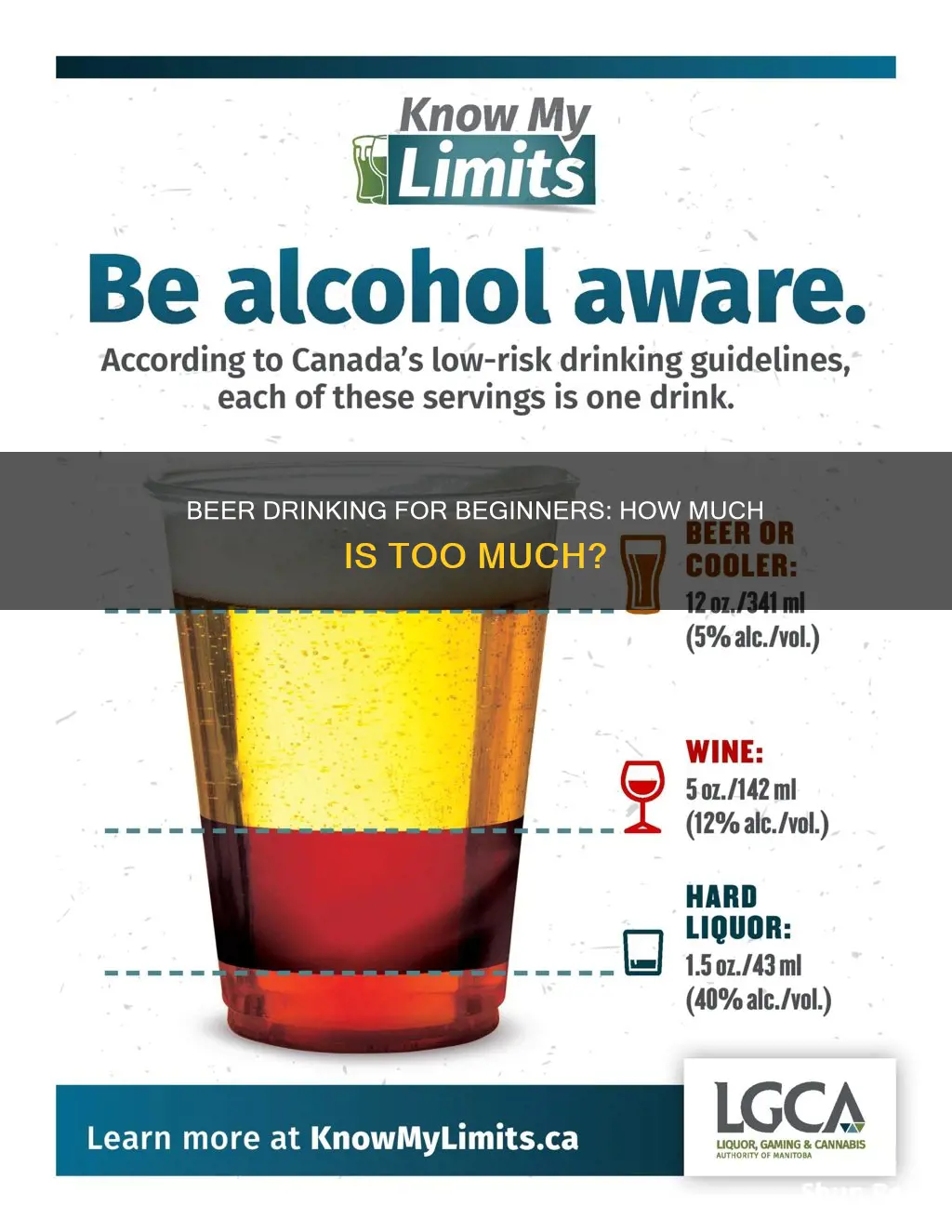
Drinking alcohol for the first time can be a daunting experience, and it's important to be aware of the risks involved. While the legal drinking age is 21 in the US, and drinking alcohol is not recommended for those under age, it's important to be informed about safe drinking practices. According to the National Institute on Alcohol Abuse and Alcoholism (NIAAA), drinking guidelines suggest limiting intake to 1 drink or less for women and 2 drinks or less for men in a single day. Binge drinking, which is defined as consuming 4 or more drinks for women and 5 or more drinks for men in about 2 hours, significantly increases the risk of alcohol-related harm, including car crashes, violence, memory blackouts, and health issues such as liver disease and cancer. It's important to remember that drinking alcohol can have serious consequences, and it should always be done in moderation to minimize risks.
| Characteristics | Values |
|---|---|
| Number of beers for women | 1-2 beers |
| Number of beers for men | 2 beers |
| Frequency | Daily |
What You'll Learn

Binge drinking
The National Institute on Alcohol Abuse and Alcoholism (NIAAA) reports that about 61.4 million people aged 12 and older in the United States, or 21.7%, engaged in binge drinking in the past month. While rates of binge drinking among preteens, teens, and young adults are decreasing, they remain high, with 28.7% of young adults aged 18-25 and 49% of full-time college students reporting binge drinking in the past month. Binge drinking among older adults is also a concern, with 12% of adults over 65 reporting binge drinking in the same period.
The negative effects of binge drinking are far-reaching and impact individuals, families, and society as a whole. Binge drinking increases the risk of acute harm, such as blackouts, alcohol poisoning, and overdose, as well as unsafe sexual behaviour, STIs, and unintentional pregnancies. It also increases the likelihood of potentially deadly consequences, including falls, burns, drownings, and car crashes. Research suggests that even a single episode of binge drinking can compromise immune system function and lead to acute pancreatitis in individuals with underlying pancreatic damage.
The impact of binge drinking extends beyond immediate health risks. Heavy drinking is associated with memory problems in young adults, mental health issues, and a higher chance of developing various types of cancer, including breast, throat, oesophageal, and colon cancer. Additionally, binge drinking can lead to social problems, such as relationship issues, and economic costs, including losses in productivity, health care costs, and property damage.
To reduce the risks associated with alcohol consumption, it is recommended to limit intake to no more than one drink per day for women and no more than two drinks per day for men. These guidelines are not averages but daily limits. It is also important to avoid drinking on an empty stomach, as this increases the rate of alcohol absorption and results in a higher blood alcohol level. Alternating alcoholic drinks with water or other non-alcoholic beverages can also help slow down consumption and reduce the risks associated with binge drinking.
Kids Drinking Beer in Ireland: Is it Normal?
You may want to see also

Heavy drinking
According to a study in Denmark, Finland, and Sweden, life expectancy among people with alcohol use disorder (AUD) was 24-28 years shorter than in the general population. For people hospitalized with AUD, average life expectancy was 47-53 years for men and 50-58 years for women.
If you think you may be drinking heavily, it's important to seek help and support to cut back or quit drinking.
Beer and Clindamycin: A Safe Mix?
You may want to see also

Alcohol-related problems
Alcohol is a leading cause of morbidity and mortality, contributing to about 5 million emergency department visits and more than 178,000 deaths in the U.S. each year. Even low levels of consumption can lead to health risks, including cancer and cardiovascular issues. Here are some alcohol-related problems:
Liver Problems
Alcohol is metabolized in the liver, and heavy drinking can lead to liver damage. Alcoholic liver disease (ALD) includes a range of conditions such as steatosis (fatty liver), steatohepatitis (inflammation), fibrosis, cirrhosis, hepatocellular carcinoma, and alcohol-associated hepatitis. Abstinence is crucial for improving ALD prognosis.
Gastrointestinal Issues
Alcohol can damage the epithelial lining of the gastrointestinal tract, leading to inflammation, bleeding, and conditions like gastroesophageal reflux disease (GERD). It also increases the risk of acute and chronic pancreatitis.
Immune System Dysfunction
Heavy alcohol use can interfere with the immune response, impairing the body's ability to fight infections and increasing the risk of inflammation and alcohol-related organ damage.
Cardiovascular Complications
Alcohol consumption is linked to an increased risk of hypertension, arrhythmias, heart attacks, and strokes. Even low drinking levels may elevate the risk.
Neurological and Mental Health Issues
Alcohol affects the brain's communication pathways, leading to difficulties in thinking, speaking, memory, and movement. It can also cause mental health issues like depression and dementia, and increase the risk of epilepsy.
Cancer
Alcohol is a carcinogen associated with cancers of the oral cavity, pharynx, larynx, esophagus, colon, rectum, liver, and female breast. The risk of breast cancer increases with less than one drink per day.
Sleep Disturbances
While alcohol may initially induce sleep, it can disrupt sleep quality and increase the risk of snoring and sleep apnea.
Gout
Alcohol consumption, especially beer and liquor, can contribute to the development of gout due to the buildup of uric acid in the joints.
Fear of Drinking Corona Beer?
You may want to see also

Alcohol metabolism
It is not recommended that individuals who are underage, managing certain health conditions, taking certain medications, or planning to operate machinery or drive a vehicle consume alcohol. The U.S. Dietary Guidelines advise that, in a single day, women should have one drink or less, and men should have two drinks or less. Drinking more than this amount is considered heavy drinking, which increases the risk of acute and chronic health problems.
When alcohol is swallowed, about 25% is directly absorbed into the bloodstream from the stomach, and the rest is mostly absorbed from the small intestine. Food in the stomach can slow down the absorption of alcohol. Once in the bloodstream, alcohol is carried to all organs in the body.
The liver is the primary organ responsible for breaking down alcohol. About 90-98% of alcohol is broken down in the liver, and the remaining 2-10% is excreted in urine, sweat, or breath. The liver breaks down alcohol into acetaldehyde, which is then broken down into acetate. Acetate is further metabolised into carbon dioxide and water, which are eliminated from the body.
The rate at which alcohol is metabolised varies widely among individuals due to factors such as liver size, body mass, and genetics. For example, some people of East Asian descent have genetic variations that affect the enzymes responsible for processing alcohol, leading to a buildup of acetaldehyde and an increased risk of cancer.
It is important to note that there is no guaranteed safe amount of alcohol for anyone, and the less alcohol consumed, the better.
Beer and Polycythemia Vera: What You Need to Know
You may want to see also

Alcohol-related health issues
It is important to note that there is no guaranteed safe amount of alcohol for anyone. The U.S. Dietary Guidelines recommend that, for healthy adults who choose to drink, alcohol-related risks may be minimized by limiting intake to one drink or less in a day for women, and two drinks or less in a day for men. These amounts are not averages but rather a daily limit.
With that said, here is some information on alcohol-related health issues:
Liver Disease
The liver is the main organ responsible for metabolizing alcohol. Heavy drinking takes a toll on the liver and can lead to a variety of problems and inflammations, including steatosis (fatty liver), hepatitis (liver swelling), fibrosis (accumulation of certain types of protein), and cirrhosis (where scar tissue replaces healthy liver cells).
Pancreatitis
Alcohol causes the pancreas to produce toxic substances that can lead to pancreatitis, a dangerous inflammation that causes swelling and pain and impairs the pancreas's ability to produce enzymes and hormones for proper digestion.
Cancer
According to the National Cancer Institute, there is a strong scientific consensus that alcohol drinking can cause several types of cancer. The more alcohol a person drinks, the higher their risk of developing an alcohol-associated cancer. Even those who have no more than one drink per day and people who binge drink have a modestly increased risk of some cancers. Examples of alcohol-related cancers include head and neck cancer, esophageal cancer, and breast cancer.
Immune System Dysfunction
Chronic heavy drinking can negatively affect the immune system by decreasing the number of immune cells and increasing the risk of infections. Research has found a link between heavy alcohol consumption and the risk of acquiring pneumonia and tuberculosis. Drinking a lot on a single occasion slows the body's ability to ward off infections for up to 24 hours afterward.
Brain and Nervous System Problems
Alcohol affects the brain's communication pathways, making it harder to think and speak clearly, remember things, make decisions, and move the body. Heavy drinking can also cause mental health issues like depression and dementia, as well as painful nerve damage that may linger long after the person sobers up. Regular overconsumption of alcohol over many years may also lead to the development of alcohol-related brain damage (ARBD) and neurodegenerative conditions like Wernicke-Korsakoff syndrome.
Cardiovascular Issues
Heavy alcohol consumption can lead to the development of heart conditions. It can raise a person's blood pressure (hypertension) by triggering the release of hormones that cause blood vessels to constrict. This puts extra strain on the heart and can result in cardiovascular diseases such as congestive heart failure and heart attacks.
Unalcoholic Beer and Kids: Is It Safe to Drink?
You may want to see also
Frequently asked questions
There is no recommended amount for how much beer you should drink for the first time, but it is advised that you drink in moderation. According to the U.S. Dietary Guidelines, drinking should be limited to 1 drink or less for women and 2 drinks or less for men in a day.
Excessive drinking is divided into two categories: binge drinking and heavy drinking. Binge drinking is defined as consuming 4 or more drinks for women and 5 or more drinks for men within 2 hours. Heavy drinking is defined as consuming 8 or more drinks per week for women and 15 or more drinks per week for men.
Excessive drinking can lead to various health problems, including unintentional injuries, violence, risky sexual behaviors, memory and learning problems, early dementia, inflammation and damage to organs, chronic diseases such as liver disease and cancer, gastrointestinal issues, weakened immune system, higher risk of obesity, and mental health issues such as depression and anxiety. Excessive drinking can also impact your personal and professional life, leading to decreased productivity, job loss, financial issues, and relationship problems.







